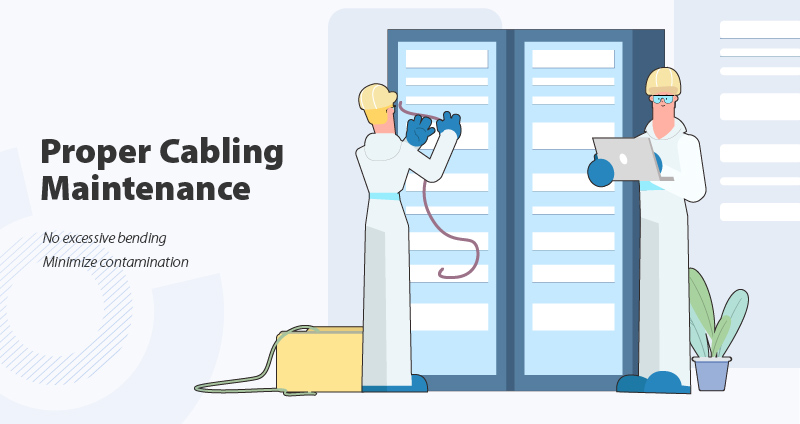3 Rules for Maximizing ROI from Fiber Cabling
Responding to the increasingly growing connectivity needs such as 5G, IoT, and other new applications, fiber networks are widely deployed. No matter for enterprises or big data centers, it's a common wish of network engineers to accomplish great profit while achieving success network setup. In this article, we'll focus on how to maximize ROI from your fiber cabling including:
-
Reasons why fiber cables are of importance in increasing your network ROI;
-
How to maximize ROI from fiber cabling throughout the network plan and O&M.
Importance of Cabling ROI in Fiber Network
As the basic infrastructure in network rollout and upgrade, planning a fiber optic cabling system is essential, which will have a great impact on the network performance.
The cost of a whole fiber network is comprised of the initial cost and the cost for O&M and future upgrades. The former includes the cost of networking hardware components and the cabling system. Apparently, the price for network equipment such as switches and routers is much more expensive than a single fiber optic cable. However, the usage of fiber cabling is widespread throughout the whole data center field.
As the basic infrastructure of the network, cabling is the foundation of everything. The usage life of fiber cabling is generally much longer than other network hardware as well as software. Generally, network hardware is expected to last 5 to 6 years but cabling can serve longer - at least ten years. Therefore fiber cabling is acknowledged as a long-span investment asset. With the explosive growth in data transmission today, how to reduce heavy cabling costs while ensuring reliable data transmission is crucial.
Approaches to Maximizing Fiber Cabling ROI
There are three approaches to maximizing ROI regarding fiber cabling.
Future-proof Cable Investment
Most network devices have a limited life span. Once they become outdated and no longer able to support network needs, it is time to replace them with next-generation devices. Generally, the lifespan of fiber cabling is longer than that of device hardware and software. The cabling system survives until the upgrading of at least three generations of network devices. Therefore, to avoid the extra cost of investment caused by frequent upgrading, build it once and leverage it several times over.
But things don't always go like this. Networks are often built this way - Networks are built based on the present urgent needs, and it takes a few years to learn that additional network infrastructure is needed to meet the customers' requirements and evolving applications. It will require repeat rip and replace upgrades. To set up a new fiber optic network, now you need a forward-thinking solution. Choose fiber optic cable plant not only for the current bandwidth such as 10G or 25G, but make it available to reuse the existing cabling system at 100G or higher bandwidth.
Right Cabling System Selection
The speed and bandwidth needed and the amount of data being transferred are increasing, and the need for fiber cabling is urgent. Your investment in cabling products matters to the fiber cabling ROI. Choosing fiber optic cables for future use is the first step, and then, the second rule is to invest in cabling products that comply with industry standards, and feature high quality and forward-looking designs.
Does your cable meet the industry standards for dB loss? Ensure the cabling product features low loss rates so that the cabling environment will run flawlessly, maximizing the net revenue in the long term. Test each segment of the cable plant after installation and termination. Make sure the measured fiber loss is acceptable.
There are many fiber cable types and some vendors are constantly developing cables with unique designs for certain deployment areas. Choosing the one that fits the application will keep your operation and maintenance at ease.
Proper Cabling Maintenance
Cable maintenance is not the thing that you always think about when you're starting building up your fiber optic network. But it is as important as the initial network layout and hardware capital expenditure. Even though you have installed high-quality fiber cabling, periodic maintenance is still a must. Poor maintenance will screw it up. To design a fiber cabling network that does not need too much maintenance, there are some keys to bear in mind.

Ensure every cable is well installed and avoid excessive bending. Do not make the high bend loss ruin your network installation. The cost of missing the inspection process can be extremely huge.
Then carefully inspect and clean. The optics can get contaminated during shipping, while this contamination will increase insertion loss and can lead to network downtime. Therefore, make sure the connector end faces are clean, and minimize the risks by following inspection, clean and inspect.
Proper cabling maintenance makes it easier and less time-consuming for network operators, thus saving the cost of ownership because of the ease of maintenance.
Takeaway
To sum up, as the foundation of fiber network infrastructure, fiber cabling requires much attention in maximizing fiber network ROI. Remember to consider future use and build it once, choose high-quality cable product fitting in the scenario, and do proper cabling maintenance.
You might be interested in
Email Address

-
PoE vs PoE+ vs PoE++ Switch: How to Choose?
Mar 16, 2023














